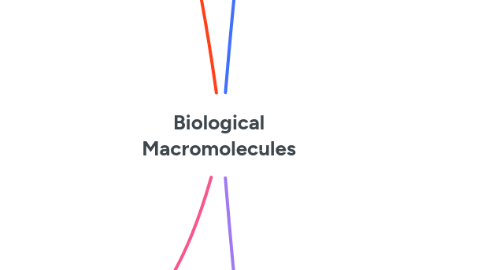
1. Lipids
1.1. Steroids
1.1.1. four ring structure + fatty acid tail
1.1.1.1. hormones + membrane stability (cholesterol)
1.1.1.1.1. cholesterol is found in animal cells and helps maintain proper fluidity of the cell membrane
1.2. Triglyceride
1.2.1. nonpolar (3 fatty acids + glycerol)
1.2.1.1. energy for the cell
1.3. Phospholipids
1.3.1. fat + phosphate + small polar/organic molecule
1.3.1.1. used in biological membranes due to amphipathic nature
1.4. Glycolipids
1.4.1. 2 fatty acids + serine + carbohydrate
1.4.1.1. membrane lipid - same as a phospholipid except no phosphate group
1.5. sphingomyelin
1.5.1. choline group + serine + fatty acid tails
1.5.1.1. membrane lipid - overlaps with glycolipid
2. Nucleic Acids
2.1. Polymers from Nucleotides
2.1.1. phosphate group
2.1.2. pentose sugar
2.1.2.1. either deoxyribose or ribose
2.1.3. nitrogenous base
2.1.3.1. Purines
2.1.3.1.1. Adenine
2.1.3.1.2. Guanine
2.1.3.2. Pyrimidines
2.1.3.2.1. Thymine
2.1.3.2.2. Uracil
2.1.3.2.3. Cytosine
2.2. Function
2.2.1. RNA
2.2.1.1. ribonucleotide
2.2.1.1.1. ribose sugar + phosphate + nitrogenous base
2.2.1.2. found in Smooth ER and Rough ER and in cytosol
2.2.1.3. copies information from DNA and provides the information to synthesize proteins
2.2.2. DNA
2.2.2.1. deoxyribonucleotide
2.2.2.1.1. deoxyribose sugar + phosphate + nitrogenous base
2.2.2.2. found in Nucleus of cell
2.2.2.3. Holds genetic information
3. Proteins
3.1. Building block: Amino acids
3.1.1. Structure
3.1.1.1. Basic: H, NH2, COOH, R-group
3.1.1.2. Spacial
3.1.1.2.1. Primary
3.1.1.2.2. Secondary
3.1.1.2.3. Tertiary
3.1.1.2.4. Quaternary
3.1.2. Variety
3.1.2.1. 20 common
3.1.2.2. Decided by: R-groups
3.1.3. Characteristics
3.1.3.1. Charged R
3.1.3.1.1. Hydrophilic
3.1.3.1.2. Negative charge
3.1.3.1.3. Positive charge
3.1.3.2. Polar but uncharged R
3.1.3.2.1. Hydrophilic
3.1.3.2.2. O, N
3.1.3.3. Nonpolar and uncharged R
3.1.3.3.1. Hydrophobic
3.1.3.3.2. C, H, S
3.1.4. Locations
3.1.4.1. Muscle, blood, other tissues
3.1.5. Functions
3.1.5.1. Catalyze
3.1.5.2. Structural support
3.1.5.3. Transportation and storage
3.1.5.4. Immume
3.1.5.5. Muscle
4. **Carbohydrates**
4.1. Disacccharides (Formed by combing two monosaccharides)
4.1.1. **Sucrose**
4.1.1.1. transports carbon along the plant body
4.1.1.2. found in plants
4.1.2. **Maltose**
4.1.2.1. energy source of plants + animals (can be broken down into glucose quickly)
4.1.2.2. commonly found in wheat, corn
4.1.3. **Lactose**
4.1.3.1. commonly found in dairy products (milk, cheese, yogurt)
4.1.3.2. broken down into glucose in the liver for energy and ATP production
4.2. Monosaccharides (Simple carbhoydrates)
4.2.1. **Glucose**
4.2.1.1. *MAIN SOURCE OF ENERGY * (ATP) *C6-H12-O6 *
4.2.1.2. Found naturally in honey and fruits
4.2.2. **Fructose**
4.2.2.1. used as cataylst for metabolic biological reactions
4.2.2.2. found naturally in fruits; converted in the liver for energy
4.2.3. **Galactose**
4.2.3.1. supports cell structure
4.2.4. **Dehydration** **Synthesis**
4.2.4.1. Chemical reaction that removes a water molecule.
4.2.4.2. Creates a glycosidic bond between two monosaccharides
4.2.4.3. RESULT
4.3. Polysaccharides (Long chains of monosaccarhides)
4.3.1. Starches
4.3.1.1. found in plants
4.3.1.2. energy storage
4.3.2. Glycogen
4.3.2.1. stored in the liver and muscles of animals
4.3.2.2. energy storage
4.3.3. Cellulose
4.3.3.1. aids in digestion
4.3.3.2. supports plant structures
